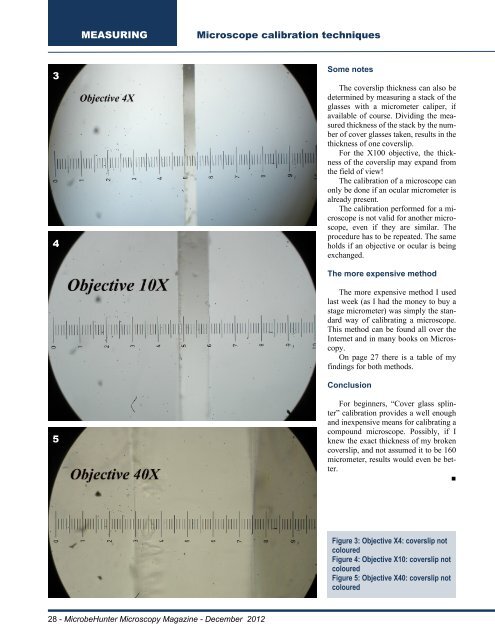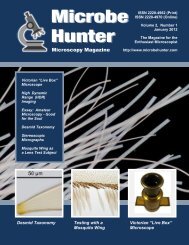December 2012 - MicrobeHunter.com
December 2012 - MicrobeHunter.com
December 2012 - MicrobeHunter.com
Create successful ePaper yourself
Turn your PDF publications into a flip-book with our unique Google optimized e-Paper software.
MEASURINGMicroscope calibration techniques34Some notesThe coverslip thickness can also bedetermined by measuring a stack of theglasses with a micrometer caliper, ifavailable of course. Dividing the measuredthickness of the stack by the numberof cover glasses taken, results in thethickness of one coverslip.For the X100 objective, the thicknessof the coverslip may expand fromthe field of view!The calibration of a microscope canonly be done if an ocular micrometer isalready present.The calibration performed for a microscopeis not valid for another microscope,even if they are similar. Theprocedure has to be repeated. The sameholds if an objective or ocular is beingexchanged.The more expensive methodThe more expensive method I usedlast week (as I had the money to buy astage micrometer) was simply the standardway of calibrating a microscope.This method can be found all over theInternet and in many books on Microscopy.On page 27 there is a table of myfindings for both methods.Conclusion5For beginners, “Cover glass splinter”calibration provides a well enoughand inexpensive means for calibrating a<strong>com</strong>pound microscope. Possibly, if Iknew the exact thickness of my brokencoverslip, and not assumed it to be 160micrometer, results would even be better.■Figure 3: Objective X4: coverslip notcolouredFigure 4: Objective X10: coverslip notcolouredFigure 5: Objective X40: coverslip notcoloured28 - <strong>MicrobeHunter</strong> Microscopy Magazine - <strong>December</strong> <strong>2012</strong>










